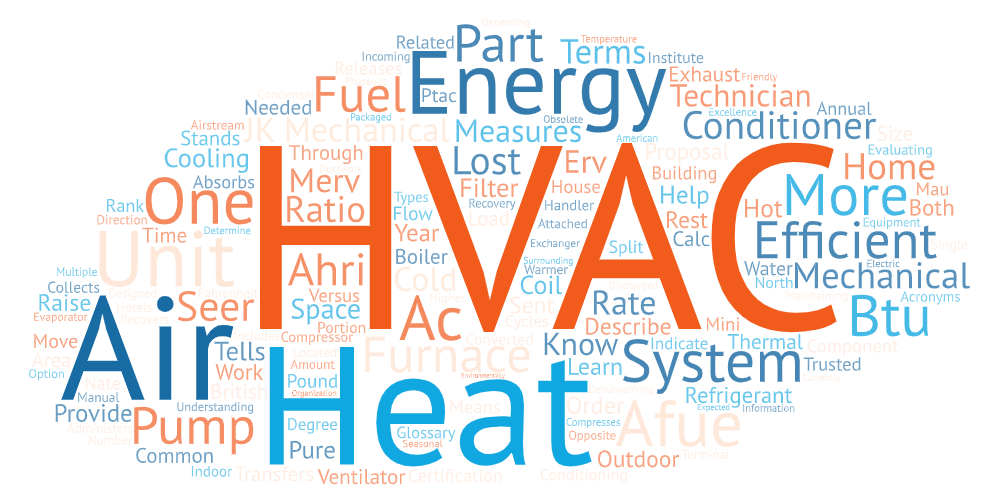HVAC Terms You Should Know
AHRI. SEER. BTU. No, this isn’t Wordle, just a few HVAC-related terms and acronyms you might see on your JK work order or proposal during the process of repair or getting an estimate for a new HVAC system.
Understanding your system and the parts, components, and terms that describe it can help you in maintaining your system and evaluating proposals from your trusted HVAC technician. Here, we’ve compiled just a few of the most common terms and acronyms you may find helpful to know:
AC: Air Conditioner
AFUE: “Annual Fuel Efficiency Ratio.” AFUE measures the energy efficiency of your heating system (furnace or boiler). It tells you how much of your fuel is used to heat your home versus how much energy is lost through exhaust. A furnace with a 80% AFUE rating means that 80% of the fuel is converted into heat while 20% is lost through exhaust.
AHRI: The Air Conditioning, Heating, and Refrigeration Institute. Administers certification for HVAC equipment.
BTU: British Thermal Unit. A measurement of energy (heat) used to indicate the rate of cooling, dehumidifying, or heating in an HVAC system. One BTU is the amount of energy needed to raise the temperature of one pound of pure water by one degree Fahrenheit.
Compressor: Part of an outdoor air conditioner or heat pump that compresses and pumps refrigerant to provide cooling.
Condenser: The outdoor portion of an air conditioner or heat pump that either releases or collects heat, depending on the time of the year.
ERV: Energy Recovery Ventilator. Recovers energy from the airstream discharged from the building and transfers this energy to the incoming air used for ventilation.
Evaporator Coil: Part of an air conditioner or heat pump that absorbs heat from the air in your house. Located in the air handler or attached to the furnace.
Heat Exchanger: A heating component in a furnace that transfers heat to the surrounding air, to be sent to the rest of the home
Heat Pump: A compressor that cycles both hot and cold air. It is designed to move thermal energy in the opposite direction of heat flow by absorbing heat from a cold space, which is released to a warmer space.
HVAC: Stands for “Heating, Ventilation, and Air Conditioning.”
Load Calc/Manual J: The measurement system used to determine the size of HVAC system needed for a home, building, or area.
MAU: Make-up Air Unit. For more information, click here.
MERV: Minimum Efficiency Reporting Values, or MERVs, report a filter’s ability to capture larger particles between 0.3 and 10 microns (µm). Used to rank the efficiency of air filters (MERV 8, MERV 13, etc). The higher the number, the more efficient the filter.
Mini-Split: An HVAC system that includes an outdoor unit and one or multiple indoor units. Useful for heating and cooling spaces without ductwork.
NATE: North American Technician Excellence. A non-profit certification organization for HVAC technicians.
PTAC: “Packaged Terminal Air Conditioner.” An electric single unit that provides heat and AC. Common in hotels and other similar facilities.
R22/R410a: Types of refrigerants. R22 is currently obsolete, while the R410a phaseout to a more environmentally-friendly option is expected.
SEER: Stands for “Seasonal Energy Efficiency Ratio.” Used to describe how energy efficient an Air Conditioner is.
If you have questions about the HVAC terms and phrases you encounter during your research process or service appointment, our trained and certified technicians are here to help. Talk to your JK service technician at your next appointment or contact us here to learn more.



